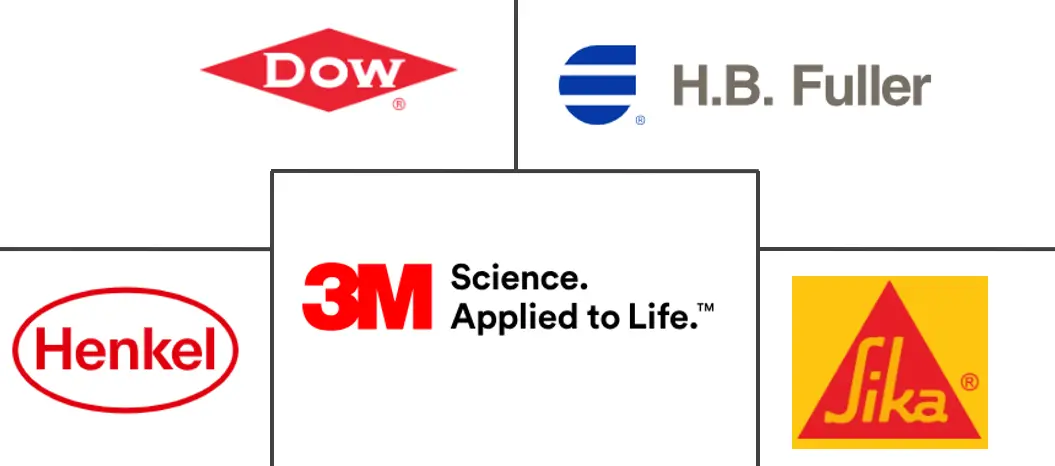Polyurethane (PU) Adhesives In Electronics Market Size and Share
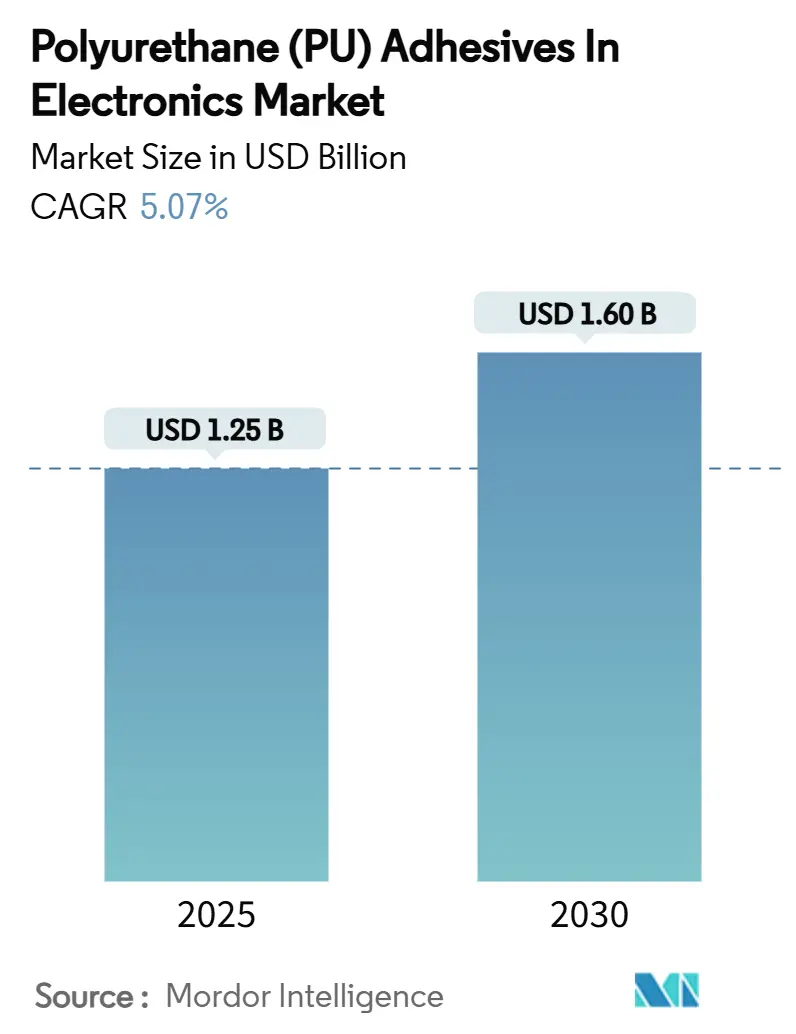
Polyurethane (PU) Adhesives In Electronics Market Analysis by Mordor Intelligence
The Polyurethane Adhesives In Electronics Market size is estimated at USD 1.25 billion in 2025, and is expected to reach USD 1.60 billion by 2030, at a CAGR of 5.07% during the forecast period (2025-2030). This steady expansion rests on the growing importance of high-performance bonding materials for electric-vehicle (EV) battery packs, the continuing miniaturization of consumer devices, and stricter safety regulations that favor low-emission chemistries. Vendors are prioritizing rapid-cure, precision-dispense technologies that help shrink production tact times, especially in high-volume Asian factories. Investments in thermally conductive and UV-curing chemistries are accelerating as designers confront higher power densities in power modules and automotive inverters. Cost volatility for polyols and diisocyanates remains a headwind, yet strong downstream demand, particularly from flexible-hybrid electronics, keeps overall momentum positive.
Key Report Takeaways
- By product type, UV-curing grades led with 64.26% revenue share in 2024; they also post the fastest growth at a 5.49% CAGR through 2030.
- By application, surface mounting accounted for 78.14% share of the polyurethane adhesives in the electronics market size in 2024 and is advancing at a 5.18% CAGR through 2030.
- By geography, Asia-Pacific held 73.05% of polyurethane adhesives in the electronics market share in 2024, while the same region is projected to expand at a 5.37% CAGR to 2030.
Global Polyurethane (PU) Adhesives In Electronics Market Trends and Insights
Driver Impact Analysis
| Drivers | (~) % Impact on CAGR Forecast | Geographic Relevance | Impact Timeline |
|---|---|---|---|
| Miniaturization of consumer devices boosting demand for low-viscosity PU potting adhesives | + 1.2% | Global, with concentration in Asia-Pacific manufacturing hubs | Medium term (2-4 years) |
| EV battery thermal-gap fillers based on thermally-conductive PU | + 1.8% | Global, with early adoption in North America and Europe | Long term (≥ 4 years) |
| Environmental push toward water-borne, low-VOC PU dispersions | + 0.9% | North America and EU regulatory-driven, expanding globally | Short term (≤ 2 years) |
| Flexible hybrid electronics needing stretchable, self-healing PU bonds | + 0.7% | Asia-Pacific core, spill-over to North America | Long term (≥ 4 years) |
| High-temperature SiC power modules requiring low-outgassing PU die-attach | + 0.6% | Global, with concentration in automotive and industrial sectors | Medium term (2-4 years) |
| Source: Mordor Intelligence | |||
Miniaturization of Consumer Devices Boosting Demand for Low-Viscosity Potting Adhesives
Wearables, hearables, and IoT sensors continue to shrink, leaving little room for mechanical fasteners. Designers therefore rely on ultra-low-viscosity polyurethane formulations, often below 1,000 cPs, that flow into 150 µm gaps without void creation. These materials encapsulate fragile chips, mitigate vibration, and survive -55 °C to 100 °C thermal cycles, as demonstrated by Protavic’s PNU-46202 series. Sharp reductions in part counts cut assembly costs, which reinforces demand for high-function potting chemistries across the polyurethane adhesives in the electronics market. Asian outsourced-assembly providers are specifying the new grades in volume because they enhance first-pass yields and reduce rework. Over the medium term, growing adoption in augmented-reality headsets will magnify the positive CAGR contribution.
EV Battery Thermal-Gap Fillers Based on Thermally Conductive Polyurethane
Battery packs now carry up to 100 kWh of energy, making thermal runaway avoidance a design priority. Thermally conductive polyurethane adhesives dissipate heat while electrically insulating cells, combining two critical functions in a single dispense step. Dow’s carbon-nanotube-enhanced formulations achieve 5 W/m·K conductivity with sub-0.5% shrinkage, reducing pack stresses and extending cycle life. As EV adoption accelerates, tier-one suppliers are locking in multiyear supply contracts, ensuring that this driver delivers the highest incremental growth within the polyurethane adhesives in electronics market.
Environmental Push Toward Water-Borne, Low-VOC Polyurethane Dispersions
The 2023 EU restriction requiring user training for diisocyanate systems above 0.1% concentration, mirrored by Canada’s 2024 VOC limits, is forcing reformulation away from solvent-borne variants. Henkel’s Micro-Emission product line answers with less-than-0.1% free monomer content, enabling factory compliance without extra certifications. Early adopters report 20% shorter permitting cycles and lower insurance premiums, advantages that make the polyurethane adhesives in electronics market more resilient to future regulatory tightening.
Flexible-Hybrid Electronics Needing Stretchable, Self-Healing Bonds
Bio-integrated sensors and foldable displays demand adhesives that elongate beyond 300% while retaining conductivity. Recent academic breakthroughs show polyurethane–PEDOT: PSS blends healing 95% of initial resistance in 10 minutes at room temperature[1]Royal Society of Chemistry, “Self-Healing Conductive Blends,” pubs.rsc.org . Consumer-electronics OEMs are piloting these chemistries in soft patches for continuous glucose monitoring. As commercialization progresses, new premium niches are forming inside the polyurethane adhesives in the electronics market, though supply chains must scale specialty precursors to meet long-term demand.
Restraint Impact Analysis
| Restraints | (~) % Impact on CAGR Forecast | Geographic Relevance | Impact Timeline |
|---|---|---|---|
| VOC/isocyanate exposure regulations tightening globally | -1.4% | Global, with EU and North America leading regulatory implementation | Short term (≤ 2 years) |
| Polyol and diisocyanate price volatility pressuring margins | -0.8% | Global, with particular impact on cost-sensitive applications | Medium term (2-4 years) |
| Rise of silane-terminated prepolymer alternatives in wearables | -0.5% | Asia-Pacific and North America, concentrated in consumer electronics | Long term (≥ 4 years) |
| Source: Mordor Intelligence | |||
VOC and Isocyanate Exposure Regulations Tightening Globally
EPA and REACH frameworks now cap indoor formaldehyde at 0.062 mg/m³ and mandate operator training for diisocyanate handling[2]U.S. Environmental Protection Agency, “VOC Emission Standards,” epa.gov. Smaller EMS companies face compliance investments topping USD 250,000 for fume extraction and certification, pushing them toward alternative chemistries. Separate SKUs for different jurisdictions raise inventory costs, slowing new-product introductions. Although major suppliers are unveiling low-monomer grades, qualification cycles stretch six to nine months, dampening near-term orders in the polyurethane adhesives in the electronics market.
Polyol and Diisocyanate Price Volatility Pressuring Margins
Feedstock constraints sent MDI and TDI spot prices soared in February 2024, compressing margins for formulators tied to fixed-price contracts. Japanese polyether polyol demand dipped in tandem with a regional automotive slowdown, highlighting the sensitivity of global supply chains. Some OEMs shifted to long-term index-linked agreements, but smaller buyers cannot hedge as effectively, which tempers expansions and slows uptake of new polyurethane grades. Bio-based polyols promise diversification yet carry premiums of 15-20%, restricting adoption to high-value sub-segments.
Segment Analysis
By Product Type: UV-Curing Grades Underpin High-Speed Assembly
Surface-flash curing polyurethane formulations commanded 64.26% revenue in 2024, a position they are set to strengthen by expanding at 5.49% CAGR to 2030. This leadership underscores how the polyurethane adhesives in the electronics market benefit when assembly lines slash dwell times from minutes to seconds. Many contract manufacturers now operate inline UV tunnels that cure 50 µm bond lines in under two seconds, delivering cycle-time savings near 30%. The rapid-cure feature also minimizes fixturing, which simplifies automated dispensing on densely populated boards.
Electrically conductive and thermally conductive variants round out the portfolio. Although they trail in volume, they capture above-average margins by solving mission-critical challenges such as thermal spreading in LED arrays or grounding paths in camera modules. Hybrid dual-cure chemistries that combine UV initiation with secondary moisture curing address shadowed joints, broadening the reachable share of the polyurethane adhesives in the electronics market. Emerging heat-activated products remain niche but draw interest in foldable displays that cannot tolerate high peak irradiance.
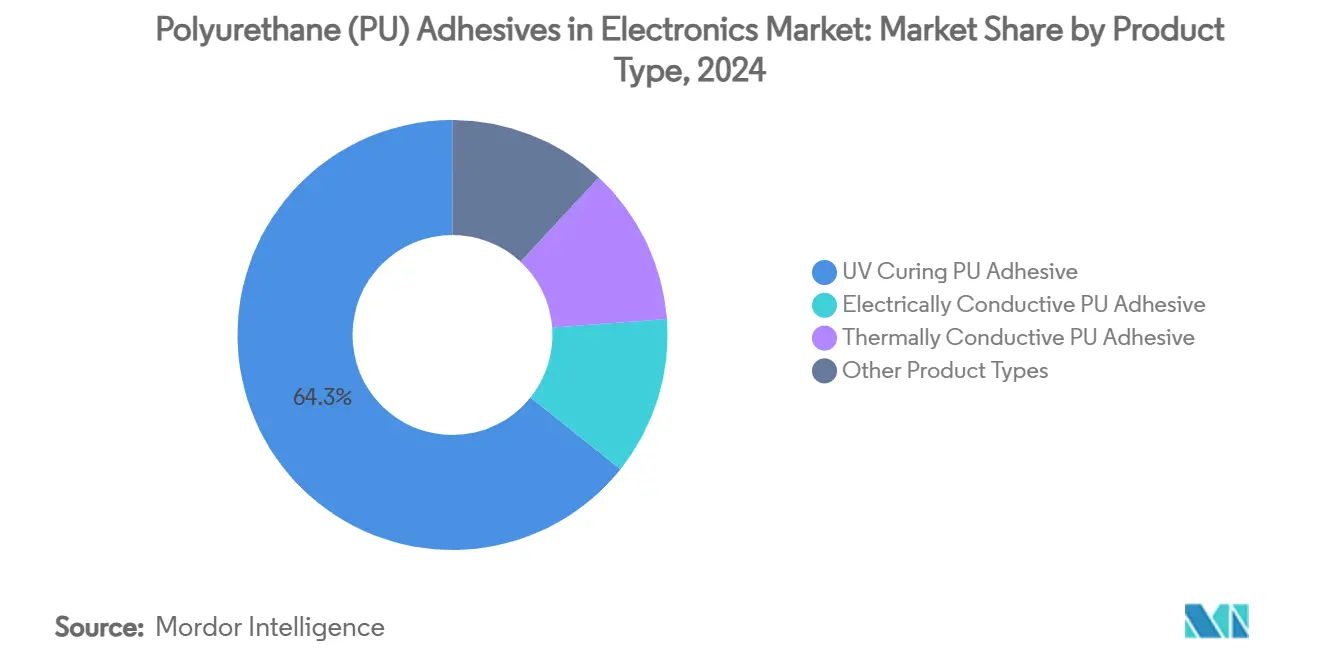
Note: Segment shares of all individual segments available upon report purchase
By Application: Surface Mounting Anchors Volume Demand
Surface mounting retained 78.14% share of 2024 revenues and is projected to expand at 5.18% CAGR, supported by ever-smaller 0201 passives and 100+ I/O system-in-package modules that require positional accuracy within ±25 µm. Temporary chip-bond adhesives secure parts through reflow and then decompose cleanly, preventing tombstoning without interfering with solder joints. Conformal coating is the secondary value pool, favored for automotive body-control modules that must survive salt-spray and 105 °C under-hood temperatures. Specialized urethane chemistries offer moisture protection superior to acrylics but introduce rework complexity, which limits broader uptake.
Wire tacking, potting, and optical bonding create differentiated opportunities. Potting materials that flow into sub-0.2 mm gaps without air entrapment address fan-out wafer-level packages used in high-pixel-density image sensors. Optical clear adhesives with refractive-index stability over 125 °C cycles are gaining orders in mini-LED backlighting units. Collectively these niches generate premium margins, keeping them strategically important inside the polyurethane adhesives in electronics market even though they do not yet move overall tonnage.
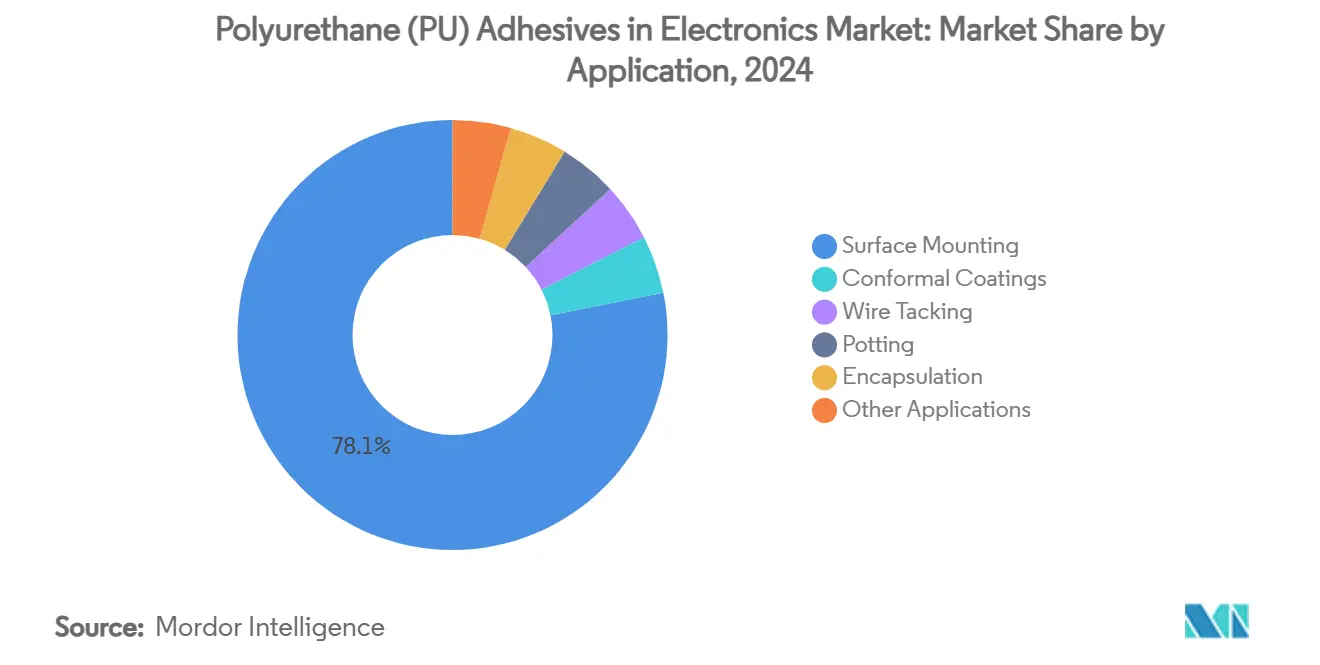
Note: Segment shares of all individual segments available upon report purchase
Geography Analysis
Asia-Pacific dominated with 73.05% revenue share in 2024 on the back of China’s unmatched PCB, smartphone, and EV-battery output. Factory clusters in Shenzhen and Shanghai consume high-throughput UV grades that cure under conveyor-belt UV LEDs in less than three seconds, reinforcing regional scale advantages. South Korea’s semiconductor fabs drive consumption of thermally conductive polyurethane interfaces that cope with 450 W chip heat-flux densities.
North America is buoyed by EV battery production in Michigan, Tennessee, and Ontario, which is fueling orders for 2 W/m·K gap fillers, while aerospace primes in Washington and Texas specify low-density syntactic polyurethane potting compounds that shave grams from satellite control boards. Regulatory rigor, EPA VOC limits, and OSHA-dictated exposure thresholds make water-borne dispersions more popular, positioning local formulators that pivot early for share gains in the polyurethane adhesives in electronics market.
Europe shows balanced growth tied to automotive electrification targets. The German premium-car segment increasingly specifies polyurethane structurals that provide impact resistance for battery enclosures. Meanwhile, REACH Annex XVII limits on free monomer diisocyanates push OEMs to new micro-emission chemistries. Emerging clusters in Poland and Hungary, supplied by Asian EMS players, are likely to raise Eastern European consumption through 2030. Middle-East and Africa, and South America remain nascent, but rising handset assembly in Vietnam-backed African ventures hints at longer-term upside.
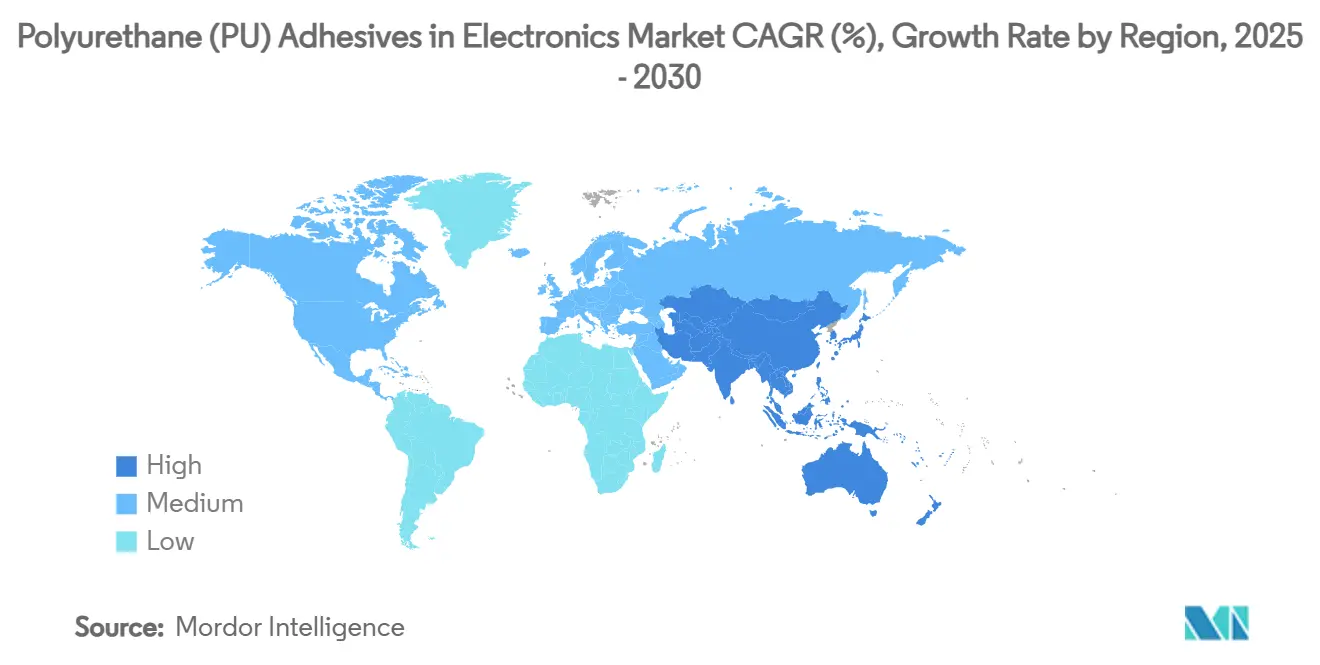
Competitive Landscape
The market is moderately fragmented. Global leadership rests with multinational chemical firms that leverage deep research and development pipelines, wide logistics networks, and application labs near customer plants. Mid-tier specialists thrive on focus. Asian regional players, including Shanghai Sepna, capture domestic demand through proximity and cost advantages, but they face tightening VOC rules and growing mergers and acquisitions interest from Western strategics. Meanwhile, customers reward suppliers that can pre-qualify materials against evolving safety directives, steering premium business toward those with robust compliance infrastructures inside the polyurethane adhesives in electronics market.
Polyurethane (PU) Adhesives In Electronics Industry Leaders
-
3M
-
Henkel AG & Co. KGaA
-
Sika AG
-
Dow
-
H.B. Fuller Company
- *Disclaimer: Major Players sorted in no particular order
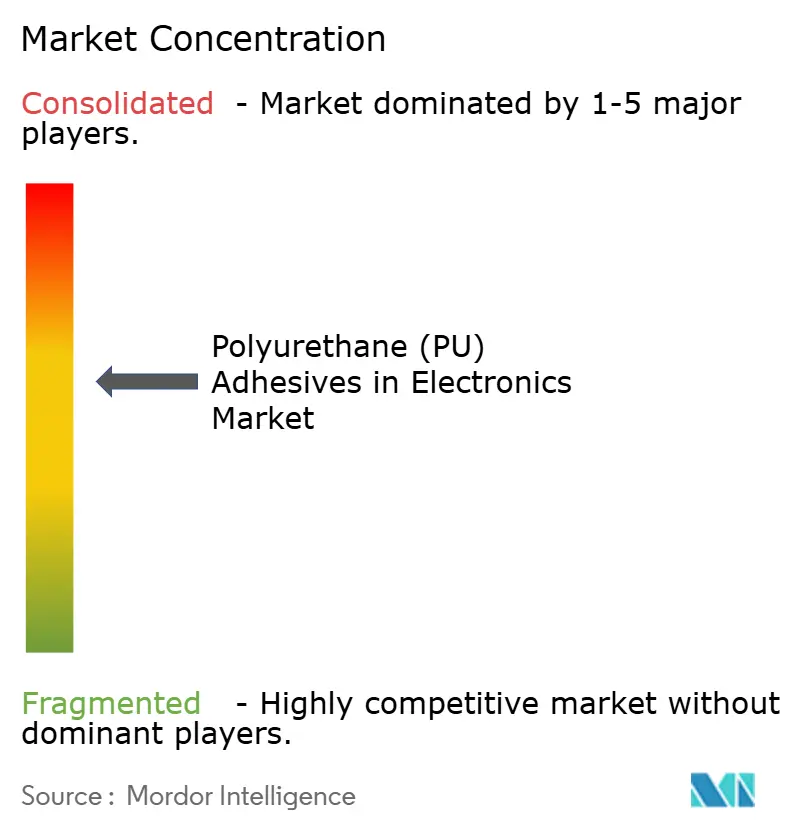


Recent Industry Developments
- February 2024: Intertronics launched Point-One structural polyurethane adhesives using micro-emission technology for low-VOC electronics bonding.
- June 2023: Henkel committed EUR 120 million (~USD 139.78 million) to a new adhesive manufacturing plant in China aimed at serving electronics, automotive, and aerospace customers
Global Polyurethane (PU) Adhesives In Electronics Market Report Scope
The polyurethane (PU) adhesives in electronics market report include:
| Electrically Conductive PU Adhesive |
| Thermally Conductive PU Adhesive |
| UV Curing PU Adhesive |
| Other Product Types |
| Surface Mounting |
| Conformal Coatings |
| Wire Tacking |
| Potting |
| Encapsulation |
| Other Applications (Display Bonding and Optical Assemblies, Battery Assembly, etc.) |
| Asia-Pacific | China |
| Japan | |
| India | |
| South Korea | |
| ASEAN | |
| Rest of Asia-Pacific | |
| North America | United States |
| Canada | |
| Mexico | |
| Europe | Germany |
| United Kingdom | |
| France | |
| Italy | |
| Spain | |
| Russia | |
| Rest of Europe | |
| South America | Brazil |
| Argentina | |
| Rest of South America | |
| Middle-East and Africa | Saudi Arabia |
| South Africa | |
| Rest of Middle-East and Africa |
| By Product Type | Electrically Conductive PU Adhesive | |
| Thermally Conductive PU Adhesive | ||
| UV Curing PU Adhesive | ||
| Other Product Types | ||
| By Application | Surface Mounting | |
| Conformal Coatings | ||
| Wire Tacking | ||
| Potting | ||
| Encapsulation | ||
| Other Applications (Display Bonding and Optical Assemblies, Battery Assembly, etc.) | ||
| By Geography | Asia-Pacific | China |
| Japan | ||
| India | ||
| South Korea | ||
| ASEAN | ||
| Rest of Asia-Pacific | ||
| North America | United States | |
| Canada | ||
| Mexico | ||
| Europe | Germany | |
| United Kingdom | ||
| France | ||
| Italy | ||
| Spain | ||
| Russia | ||
| Rest of Europe | ||
| South America | Brazil | |
| Argentina | ||
| Rest of South America | ||
| Middle-East and Africa | Saudi Arabia | |
| South Africa | ||
| Rest of Middle-East and Africa | ||


Key Questions Answered in the Report
What is the expected value of polyurethane adhesives in electronics by 2030?
The market is projected to reach USD 1.60 billion by 2030, growing at a 5.07% CAGR.
Which region drives the highest demand for these adhesives?
Asia-Pacific commands more than 70% of 2024 revenues and remains the fastest-growing region through 2030.
Why are UV-curing polyurethanes so popular in electronics assembly?
They cure in seconds, boost throughput, and captured over 64% of 2024 revenue, making them ideal for high-volume SMT lines.
How do tightening VOC rules affect the adhesives supply chain?
Regulations push formulators toward water-borne, micro-emission grades, raising R&D costs but opening premium sales opportunities.
What role do polyurethane adhesives play in EV battery packs?
Thermally conductive grades manage heat, bond structural elements, and help prevent thermal runaway, supporting rapid EV adoption.
Page last updated on:
